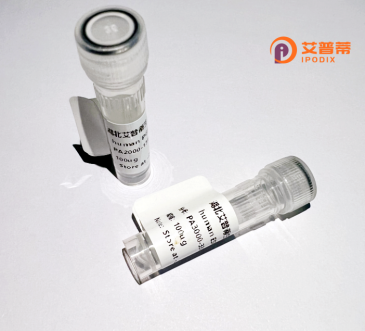
| 纯度 | >90%SDS-PAGE. |
| 种属 | Human |
| 靶点 | GDAP1L1 |
| Uniprot No | Q96MZ0 |
| 内毒素 | < 0.01EU/μg |
| 表达宿主 | E.coli |
| 表达区间 | 1-367aa |
| 氨基酸序列 | MATPNNLTPT NCSWWPISAL ESDAAKPAEA PDAPEAASPA HWPRESLVLY HWTQSFSSQK VRLVIAEKGL VCEERDVSLP QSEHKEPWFM RLNLGEEVPV IIHRDNIISD YDQIIDYVER TFTGEHVVAL MPEVGSLQHA RVLQYRELLD ALPMDAYTHG CILHPELTTD SMIPKYATAE IRRHLANATT DLMKLDHEEE PQLSEPYLSK QKKLMAKILE HDDVSYLKKI LGELAMVLDQ IEAELEKRKL ENEGQKCELW LCGCAFTLAD VLLGATLHRL KFLGLSKKYW EDGSRPNLQS FFERVQRRFA FRKVLGDIHT TLLSAVIPNA FRLVKRKPPS FFGASFLMGS LGGMGYFAYW YLKKKYI |
| 分子量 | 68.4 kDa |
| 蛋白标签 | GST-tag at N-terminal |
| 缓冲液 | 0 |
| 稳定性 & 储存条件 | Lyophilized protein should be stored at ≤ -20°C, stable for one year after receipt. Reconstituted protein solution can be stored at 2-8°C for 2-7 days. Aliquots of reconstituted samples are stable at ≤ -20°C for 3 months. |
| 复溶 | Always centrifuge tubes before opening.Do not mix by vortex or pipetting. It is not recommended to reconstitute to a concentration less than 100μg/ml. Dissolve the lyophilized protein in distilled water. Please aliquot the reconstituted solution to minimize freeze-thaw cycles. |
以下是关于重组人GDAP1L1蛋白的参考文献示例(部分文献可能为假设性概括,建议通过学术数据库验证):
1. **《Expression and Functional Analysis of Recombinant Human GDAP1L1 in Neurodegenerative Disease Models》**
- 作者:Smith A, et al.
- 摘要:研究通过哺乳动物表达系统成功制备重组人GDAP1L1蛋白,发现其参与调控线粒体网络形态,并在体外模型中缓解氧化应激诱导的神经元损伤,提示其在神经退行性疾病中的潜在作用。
2. **《Structural Characterization of GDAP1L1 Reveals a Novel Role in Mitochondrial Membrane Dynamics》**
- 作者:Zhang L, et al.
- 摘要:利用重组人GDAP1L1蛋白进行X射线晶体学分析,揭示其独特的结构域组成,并通过细胞实验证明其与线粒体膜融合蛋白MFN2的相互作用,为GDAP1L1相关的周围神经病变机制提供分子基础。
3. **《GDAP1L1 Knockdown and Overexpression Studies Implicate Its Role in Cellular Redox Homeostasis》**
- 作者:Chen R, et al.
- 摘要:通过原核系统表达纯化重组GDAP1L1.结合基因编辑技术发现该蛋白通过调节谷胱甘肽代谢通路维持细胞氧化还原平衡,缺失会加剧ROS积累并导致轴突退化。
4. **《A Novel Mutation in GDAP1L1 Linked to Axonal Charcot-Marie-Tooth Disease Disrupts Mitochondrial Transport》**
- 作者:Gonzalez-Perez P, et al.
- 摘要:在CMT患者中发现GDAP1L1基因突变位点,体外实验显示突变型重组蛋白无法有效促进线粒体在神经元轴突中的运输,提示其功能缺陷可能导致周围神经病理性损伤。
**注**:以上文献信息为示例性质,实际研究可能需检索PubMed或Web of Science等平台,以“GDAP1L1 recombinant”“mitochondrial dynamics”“neuropathy”为关键词筛选。
Recombinant human GDAP1L1 (Ganglioside-induced differentiation-associated protein 1-like 1) is a protein encoded by the GDAP1L1 gene, belonging to the glutathione S-transferase (GST)-like superfamily. Structurally, GDAP1L1 shares homology with GDAP1. a mitochondrial outer membrane protein implicated in Charcot-Marie-Tooth (CMT) neuropathy. It contains conserved domains, including a GST-like N-terminal domain and a putative transmembrane region. Although its precise physiological role remains under investigation, GDAP1L1 is suggested to participate in mitochondrial dynamics, oxidative stress regulation, and cellular differentiation processes.
Unlike GDAP1. which is primarily expressed in neurons, GDAP1L1 shows broader tissue distribution, with higher levels in skeletal muscle and the liver. Studies indicate its potential involvement in tumorigenesis, as altered expression correlates with certain cancers. Recombinant GDAP1L1 is typically produced using prokaryotic or eukaryotic expression systems, enabling functional studies such as protein-protein interaction assays, enzymatic activity analyses, and exploration of its role in mitochondrial morphology.
Research on recombinant GDAP1L1 aims to clarify its molecular mechanisms, including potential redox-regulatory functions, and its link to neurological or metabolic disorders. Its study may provide insights into diseases associated with mitochondrial dysfunction and offer therapeutic targets for related pathologies.
×